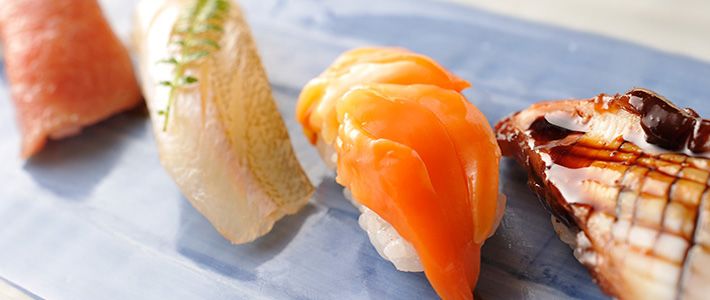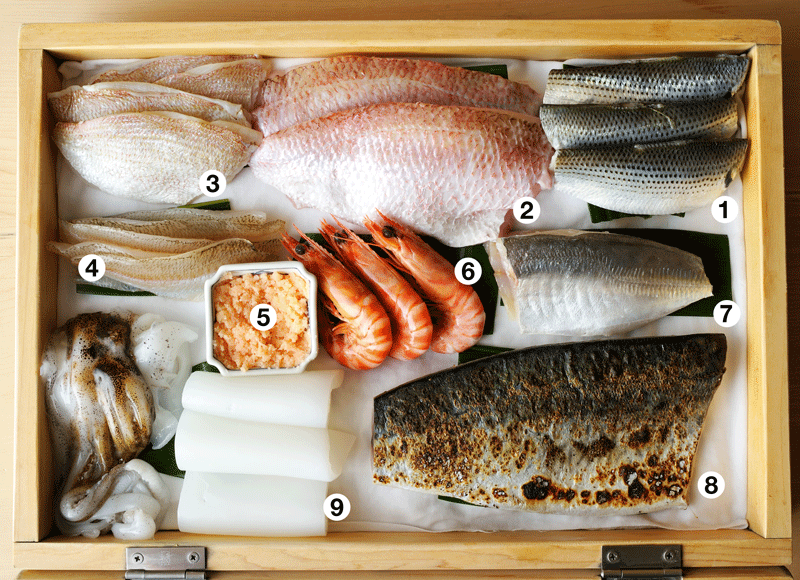
“Edomae” Sushi: A Fast Food with a Long Tradition
Guideto Japan
Food and Drink Lifestyle Culture- English
- 日本語
- 简体字
- 繁體字
- Français
- Español
- العربية
- Русский
A Look at the Edo Tradition
 Nihonbashi fish market in the Edo Period. (Photograph courtesy of Aflo.)
Nihonbashi fish market in the Edo Period. (Photograph courtesy of Aflo.)
INTERVIEWER Can you tell us about the origins of the Edomae type of sushi?
AOKI TOSHIKATSU The Edomae tradition is said to have been started in the early 1800s by Hanaya Yohei, a sushi chef in Edo (present-day Tokyo). There is a plaque in the Ryōgoku district of Sumida that bears the inscription, “Birthplace of Yohei-zushi.” The monument also describes how Yohei adapted existing dishes—like Osaka oshizushi, which combined vinegared rice with various raw seafood toppings, or neta—to create a new style of sushi in which a shari rice base and a topping were pressed together by hand to create individual bite-sized morsels. His other innovations included techniques like simmering the neta in broth, or marinating the toppings with vinegar and salt.
In the beginning, Yohei is thought to have wandered the streets in search of customers, selling his wares from a wooden carrying case. His big break came when he built himself a kiosk from which he could prepare sushi right in front of customers. This was the genesis of Edomae sushi—fast food, Edo style.
INTERVIEWER What does Edomae mean?
AOKI The term Edomae carries a double meaning. The first meaning is literally “in front of Edo,” a reference to the location of Tokyo Bay. In those days, the waters of the bay were home to a much greater variety of seafood than now: an abundance of prawns, shellfish, eel, and octopus. Edomae, then, was presumably a term locals used to boast about the many delicacies that could be caught in the nearby waters.
 A box of sushi toppings at Sushi Aoki: (1) kohada, (2) nodokuro, (3) kasugo, (4) kisu marinated in konbu, (5) oboro, (6) saimakiebi, (7) aji, (8) broiled saba, (9) ika (two types).
A box of sushi toppings at Sushi Aoki: (1) kohada, (2) nodokuro, (3) kasugo, (4) kisu marinated in konbu, (5) oboro, (6) saimakiebi, (7) aji, (8) broiled saba, (9) ika (two types).
 More Sushi Aoki toppings: (1) hamaguri, (2) tairagai, (3) kobashira, (4) kurumaebi, (5) mirugai, (6) akagai fringe, (7) torigai, (8) aoyagi.
More Sushi Aoki toppings: (1) hamaguri, (2) tairagai, (3) kobashira, (4) kurumaebi, (5) mirugai, (6) akagai fringe, (7) torigai, (8) aoyagi.
The second meaning is “work.” Old Edo lacked the transportation and refrigeration technologies that Tokyoites take for granted today. Since fresh seafood at the time would quickly start to spoil and lose its flavor, sushi chefs would go to “work” on their ingredients, using such techniques as marinating, steaming, simmering in broth, and steeping in sauces to bring out flavor and prolong shelf life.
Today, at Sushi Aoki, we try to honor the Edomae tradition while also creating new dishes suited to the tastes of today’s diners.
 Ingredients for Edomae sushi at the Tsukiji fish market include hamo (top right), akagai (bottom right), and aji (bottom left).
Ingredients for Edomae sushi at the Tsukiji fish market include hamo (top right), akagai (bottom right), and aji (bottom left).
Tuna Changing with the Times
INTERVIEWER Is it true that maguro, or tuna, was the must-have item on an Edomae menu?
AOKI Absolutely. The quality of the maguro that each shop could offer ultimately determined the relative rank of the establishment.
That said, earlier in the Edo Period [1603–1868] maguro wasn’t highly regarded as a sushi neta. It was actually described as a “lower fish,” inferior to the other varieties that people commonly ate. That was because maguro soon lost its freshness. By the time a batch reached Edo from elsewhere in Japan, it was often starting to spoil, and there would be some cuts that had gone off completely. What’s more, the maguro that did get eaten was always akami (lean, red cuts) steeped in soy sauce—it’s only in the last thirty years or so that it has become possible to enjoy the fattier cuts from the belly of the tuna, like ōtoro and chūtoro.
 Maguro, the mainstay of the Edomae menu.
Maguro, the mainstay of the Edomae menu.
 Using a paintbrush to apply the final coating of nikiri.
Using a paintbrush to apply the final coating of nikiri.
INTERVIEWER How should Edomae be eaten?
AOKI Sushi is ideally savored the moment it’s ready. The rule of thumb is that it should be served at “skin temperature.” For some dishes, though, we might adjust the temperature of the shari to better match certain neta. It’s up to the customers, of course, whether they want to eat with their fingers or with chopsticks. But, having set a plate before a diner, the chef is always pleased to see them partake as swiftly as possible.
The final stage in the preparation of a morsel of freshly pressed Edomae sushi, just before we present it to the customer, is to daub on a single coating of nikiri with a brush. This is a broth of soy sauce simmered together with mirin, a sweet rice wine vinegar. Nikiri isn’t the only condiment, though—there are others, such as a sweet sauce called tsume for boiled octopus, tako, and conger eel, anago. There’s also the unrefined salt called arajio that we use for reef squid, aoriika, or various types of white fish.
Sushi is usually also served with ginger, known as gari. In many establishments this is very finely sliced, but at our establishment we cut it into cubes. The crisp, refreshing ginger cleanses your palate so you can better enjoy the flavor of the next item. That’s one of the ideas we have to thank our predecessors for.
On the Dos and Don’ts
INTERVIEWER Is there anything one absolutely mustn’t do in a sushi restaurant?
AOKI The diners are basically free to do as they please, but you do occasionally get customers who are wearing a lot of perfume, which is something we would like to discourage. Sushi, and Japanese cuisine in general, is characterized by very subtle aromas that add to the dining experience, so wearing strong perfume can detract from the enjoyment of other patrons. For the same reason, we also have a strict no-smoking policy.
INTERVIEWER What’s the best way to go about ordering sushi?
AOKI At lunchtime, we offer set courses that start from 3,000 yen, featuring a variety of specially chosen seasonal neta. In the evenings, there are two options: omakase, where you leave the selection to us, or okonomi, where you order what you like. We usually see what we have in stock and then prepare an appetizer, or tsumami, followed by sushi. Naturally, though, the customers are welcome to stick to just sushi if they wish. Then, typically, after they have finished those servings, the guests might request a second helping of their personal favorites or whatever they particularly enjoyed that evening.
But it’s important to remember that some neta are more expensive than others. Maguro, for example, costs over 2,000 yen per serving. Perhaps the best approach is to tell us when you make your reservation just how much you are willing to spend. Then we will do our utmost to prepare the best possible menu for you within that budget. As a general rule, it makes sense for evening diners to think in terms of about 20,000 yen per person.
(Originally written in Japanese. Photographs by Uzawa Akihiko.)
▼Further reading
 Sushi Chef Aoki Toshikatsu: At the Crossroads of Tradition and Innovation Sushi Chef Aoki Toshikatsu: At the Crossroads of Tradition and InnovationNakahara Ippo |  Sushi Heaven: The Daily Artistry of a Top Ginza Chef (Video) Sushi Heaven: The Daily Artistry of a Top Ginza Chef (Video) |
tourism food Washoku dining Tokyo Ginza sushi fish shitamachi Edo

